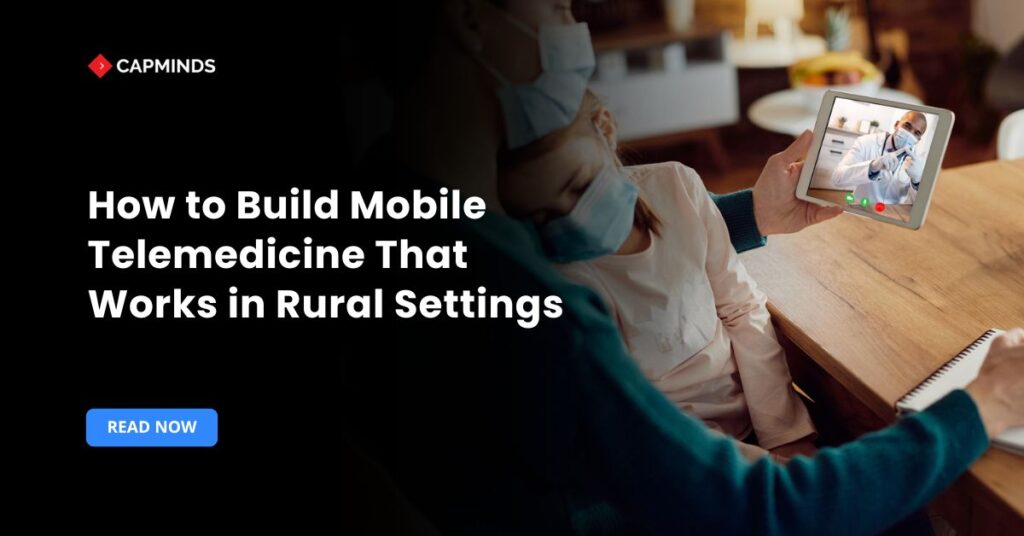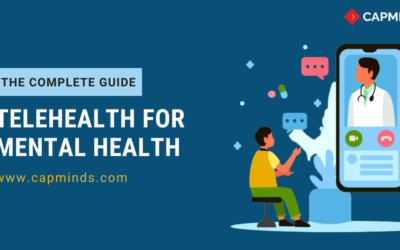How to Build Mobile Telemedicine That Works in Rural Settings
Rural America faces a healthcare crisis. Over 60 million people live in rural areas. That’s 20% of the U.S. population. These communities are older and sicker than urban areas. They need to travel long distances for care. 100+ rural hospitals closed between 2013-2020.
Rural patients travel 20+ extra miles for routine care. While all these struggles are in place, Telemedicine can help to resolve them. But it needs to work in rural settings. That means dealing with poor internet, working with older patients, and understanding rural culture.
The Rural Healthcare Problem
Rural hospitals keep closing. The Government Accountability Office tracked these closures. More than 100 facilities shut down in seven years. People now drive farther for basic care. Emergencies become life-threatening. The nearest hospital might be an hour away instead of ten minutes. More than that, the Provider Shortage becomes a huge problem. Statistics show:
- Many rural areas are Health Professional Shortage Areas
- Recruiting doctors is hard
- Small hospitals can’t compete with urban salaries
- Specialists are almost impossible to find
Economic pressures make things worse. Lower population means fewer patients. Rural demographics include more Medicare patients. Medicare pays less than private insurance.
This creates a cycle. Fewer services mean fewer patients. Fewer patients mean less revenue. Less revenue means more closures.
Barriers to Rural Telemedicine
Rural patients face multiple, interrelated barriers that impede telemedicine use:
1. Internet Problems
Internet access is terrible in rural areas. The FCC published data on this. Rural broadband lags far behind cities. Connectivity Statistics show:
- 22.3% of rural Americans lack 25/3 Mbps broadband
- Only 1-2% of urban residents lack this speed
- 27.7% of Tribal lands lack fixed broadband
- 17% of rural residents had no broadband in 2019
Poor internet means video calls don’t work. Connections drop. Audio delays happen. Images freeze. This makes medical consultations frustrating. Many rural households don’t own smartphones or tablets. Even when they do, bad internet makes devices useless for telemedicine.
2. Rules and Regulations
State licensing laws are confusing. Doctors need different licenses for different states. This makes cross-state telemedicine hard. Regulatory Challenges include: State licensing requirements vary widely, Multi-state compacts help, but don’t solve everything, Medicare and Medicaid have different telehealth rules, Private insurers make their policies, and Rural Health Clinics get lower reimbursement rates.
COVID-19 temporarily relaxed many rules. Medicare waivers were granted. Audio-only visits were allowed. But nobody knows which changes will stay.
3. Technology Skills
Having a device doesn’t mean knowing how to use it. Many rural patients struggle with technology. Digital literacy is lower in rural areas. Digital Literacy Issues:
- Rural patients have less tech experience
- Complex interfaces feel overwhelming
- Older adults struggle more with new technology
- Cultural barriers exist in some communities
- Language barriers affect non-English speakers
Some rural communities don’t trust outsiders. New technology from urban companies feels foreign. This cultural barrier hurts adoption rates.
4. Hospital and Clinic Problems
Many rural facilities lack telemedicine equipment. They don’t have trained staff. Internet connections are unreliable. Some of the common Infrastructure Problems: Poor power and internet in some clinics, no IT support available, Staff need training on new systems, EHR systems don’t integrate well, and Workflows need a complete redesign.
Even with good technology, integration is hard. Staff need training. Scheduling systems need updates. Billing codes change. This creates resistance to adoption.
What Makes Rural Telemedicine Work
1. Mobile-First Design
Rural people use phones more than computers. Your platform must work on smartphones. But rural internet is unreliable. Your app needs to work offline. Mobile Design Requirements:
- Smartphone and tablet optimization
- Offline functionality for poor connections
- SMS backup when video fails
- Local data caching
- Background sync when online
Oracle’s Community Care app works offline. Healthcare workers can update charts without the internet. Everything syncs when the connection returns. OpenEMR runs completely offline on tablets. Mobile clinics can work anywhere. This is perfect for rural areas.
Related: The Role of OpenEMR in Elevating Care Standards for Rural Health Centers
2. Smart Automation
Rural areas have few healthcare workers. AI can help stretch resources. Symptom checkers can triage patients.
Chatbots can answer basic questions. AI Applications: Symptom checkers for initial assessment, Automated appointment scheduling, SMS reminders to reduce no-shows, Basic decision support for staff, and Red flag alerts for concerning symptoms.
The goal isn’t replacing doctors. It’s making existing staff more productive. Even simple automation helps in resource-poor areas.
3. Community Workers
Community Health Workers (CHWs) are crucial. These are trusted local people. They can introduce patients to telemedicine. They provide ongoing support. CHW Benefits:
- Residents understand community culture
- Trusted relationships already exist
- Can provide one-on-one tech training
- Help troubleshoot device problems
- Bridge language and cultural gaps
The National Rural Health Association says CHWs “facilitate culturally appropriate care.” Training local people builds trust. Patients feel more comfortable with familiar faces.
4. System Integration
Rural clinics use different computer systems. Your telemedicine platform needs to work with existing EHRs.
This prevents duplicate data entry. Integration Requirements: HL7 FHIR compatibility, Sync with major EHR systems, Automatic data updates, Single patient record across systems, and Secure data exchange.
Oracle’s mobile EHR syncs with hospital systems. Rural home visits update central records. This ensures continuity of care.
5. Security and Privacy
HIPAA compliance is required. But security can’t be so complex that people won’t use it. End-to-end encryption is necessary. So is secure data storage. Security Essentials:
- End-to-end encryption for all communications
- Secure patient identity verification
- Business Associate Agreements with vendors
- Audit logging for compliance
- Simple consent processes
Best practices include encrypted health information. Secure identity checks. Thorough documentation. But workflows must stay simple for rural users.
Success Stories
1. Mayo Clinic Mobile Program
Mayo Clinic Health System created a mobile clinic program. They serve four rural Minnesota towns. The results are impressive. Program Results:
- 1,498 patient visits in the first year
- Serves Kenyon, Blooming Prairie, Sherburn, Butterfield
- Combines telehealth and in-person care
- Helped expand local broadband access
- Replaced some traditional facilities
The program didn’t just bring healthcare. It helped improve the internet infrastructure. This benefits entire communities. Economic development follows better connectivity.
2. Project ECHO
Project ECHO takes a different approach. It connects rural doctors with specialists. This builds local capacity instead of replacing it.
ECHO Model: Rural doctors present complex cases, Specialists provide guidance via video, Local providers learn to treat difficult conditions, Patients get specialist-level care locally, and Outcomes match urban specialty care.
The Agency for Healthcare Research and Quality studied ECHO. They found it “increases access to specialty treatment in rural areas.” Rural doctors can treat hepatitis C locally. They get ongoing specialist support.
3. Rural Telepsychiatry
Mental health services are scarce in rural areas. Telepsychiatry programs help fill gaps. Several successful programs exist. Program Examples:
- Alpine Healthcare Center (NH) – weekly psychologist visits
- University of Vermont – serves nursing homes in VT and NY
- Reduced hospital transfers
- Improved behavioral health access
- Weekly video consultations
These programs work because they address specific service gaps. Staff get training on facilitating sessions. Technology integrates into existing workflows.
How to Implement Telemedicine in Rural Areas
1. Partner with Local Providers
Work with local healthcare organizations from the start. This includes FQHCs, rural health clinics, and hospitals.
They know the community’s needs. Partnership Benefits: Local knowledge of community needs, existing relationships with patients, Physical locations for telemedicine visits, Integration with current workflows, and Faster adoption by local staff.
Joint pilot programs work best. When telemedicine integrates with local EHR systems, doctors adopt it faster. Local champions help drive adoption.
2. Train Community Workers
Hire local people as Community Health Workers. Train them on technology and healthcare basics. They become your local support team.
CHW Training Topics: How to operate telemedicine equipment, Troubleshooting common problems, Patient privacy requirements, Cultural competency, and When to escalate issues.
CHWs need ongoing support. Regular training updates help. Peer learning opportunities work well. Recognition programs keep them engaged.
3. Educate Patients
Patient education is crucial. Use trusted community locations. Libraries and senior centers work well. Make training hands-on. Education Strategies:
- Hands-on training sessions
- Simple materials in local languages
- Practice sessions at health fairs
- Peer support programs
- 24/7 help lines
“Test runs” help people try technology before they need it. This builds confidence. Ongoing support reduces frustration when problems happen.
4. Respect Local Culture
Rural communities have unique cultures. Your program must fit local norms. This includes language, customs, and communication styles.
Cultural Considerations: Use local imagery and messaging, provide translation services, Respect scheduling preferences, avoid conflicts with community events, and understand transportation limitations.
Train healthcare providers on video communication. Eye contact matters. Simple language works better. Patience with technical problems is essential.
5. Get Funding
Rural telemedicine programs need funding. Federal programs can help. State and foundation grants exist, too.
Funding Sources: FCC Rural Health Care Program, USDA telemedicine grants, State health technology programs, Foundation grants for rural health, and Special telecom healthcare rates.
Broadband expansion helps entire communities. Fixed wireless and satellite partnerships work. This supports economic development beyond healthcare.
6. Follow the Rules
Compliance is not optional. HIPAA requirements are strict. State telehealth laws vary. Medicare billing rules change. Compliance Requirements:
- HIPAA privacy protections
- State licensing laws
- Proper documentation
- Correct billing codes
- Regular compliance audits
Keep up with regulatory changes. Interstate licensing compacts help. Clear staff training prevents legal problems. Regular audits catch issues early.
Related: Using OpenEMR to Power Rural Health & Mobile Clinics: Device, Offline, and Sync Strategies
The Data Behind Rural Telemedicine
1. Population and Demographics
Rural America represents a significant portion of the U.S. population. Understanding these demographics helps design better programs. Rural Population Statistics show:
- 60+ million Americans live in rural areas
- 20% of the total U.S. population
- Higher percentage of older adults
- More chronic health conditions
- Lower average income levels
2. Hospital Closures
Rural hospital closures accelerated over the past decade. This creates healthcare deserts in many areas.
Hospital Closure Data:
- 100+ rural hospitals closed (2013-2020)
- 19 rural hospitals closed in 2020 alone
- 453 rural hospitals are at risk of closure
- Average closure affects 54,000 people
- Emergency services travel increases by 20+ miles
3. Internet Access
Broadband access remains a major barrier to rural telemedicine. The digital divide affects healthcare access. Broadband Statistics:
- 22.3% of rural Americans lack 25/3 Mbps broadband
- 1-2% of urban residents lack this speed
- 27.7% of Tribal lands lack fixed broadband
- 17% of rural residents had no broadband (2019)
- 1% of urban residents lacked broadband (2019)
4. Healthcare Provider Shortages
Rural areas face severe shortages of healthcare professionals. This affects all types of care. Provider Shortage Data:
- 65% of rural counties have primary care shortages
- 47% lack mental health providers
- 30% lack obstetricians
- Rural areas have 39.8 primary care doctors per 100,000 people
- Urban areas have 53.3 primary care doctors per 100,000 people
5. Economic Impact
Healthcare costs and access affect rural economies. Telemedicine can reduce some of these costs.
Cost Statistics:
- Rural patients travel an average of 37 miles for specialty care
- Average cost per trip: $89 in time and transportation
- 25% of rural patients delay care due to travel costs
- Rural hospital closure costs the community $3.8 million annually
- Telemedicine saves an average $1,500 per patient annually
6. Technology Adoption
Rural technology adoption lags behind urban areas. This affects telemedicine implementation. Technology Stats:
- 71% of rural adults own smartphones vs. 83% urban
- 58% of rural adults have tablets vs. 67% urban
- 65% of rural seniors use the internet vs. 75% urban
- 39% of rural adults use social media vs. 48% urban
- Rural broadband speeds average 25 Mbps vs. 100 Mbps in urban areas
Making Rural Telemedicine Sustainable
Sustainability requires more than good technology. It needs community buy-in. It needs ongoing funding. It needs regulatory support. The 60 million Americans in rural areas deserve good healthcare. Geographic location shouldn’t determine health outcomes. Telemedicine can help bridge this gap.
Some of the Success Factors to make rural telemedicine sustainable: Strong local partnerships, Community health worker programs, culturally appropriate design, Reliable funding streams, and Regulatory compliance.
Rural communities have unique strengths. Strong social networks exist. Community trust runs deep. Collaborative problem-solving is common. Programs that leverage these strengths succeed. Those who ignore rural culture fail. Technology must strengthen human connections, not replace them.
The future of rural healthcare depends on thoughtful telemedicine implementation. Success requires understanding rural constraints. It requires respecting local culture.
It requires sustainable funding and regulatory support. With proper planning and community engagement, mobile telemedicine can transform rural healthcare. The goal isn’t to eliminate personal relationships. It’s to extend and enhance them through the smart use of technology.
Telemedicine Solutions for Rural Healthcare: Empowering Better Access and Care
At CapMinds, we understand the unique challenges of rural healthcare and offer tailored solutions to bridge the gap between patients and providers.
Our expertise in telemedicine platform development ensures that rural communities have access to the care they need, no matter the distance or resource constraints.
Why Choose CapMinds for Your Telemedicine Needs?
- Telehealth Platform Development: Custom solutions designed to cater to the specific needs of rural healthcare providers.
- Mobile Telemedicine Application Development: Seamless mobile-first applications that work offline and under low-bandwidth conditions.
- AI & Automation: Leveraging AI-powered symptom checkers, chatbots, and automated scheduling to optimize provider time and reduce healthcare delivery costs.
- Community Engagement & Support: Implementing culturally competent solutions and engaging local health workers to foster trust and enhance patient adoption.
- Interoperability & Security: Ensuring smooth integration with EHR systems, compliance with HIPAA, and robust security features to protect patient data.
Partner with CapMinds and bring the power of telemedicine to your rural healthcare community.
Our team is here to help you navigate regulatory challenges, implement effective solutions, and expand care access in underserved regions.




